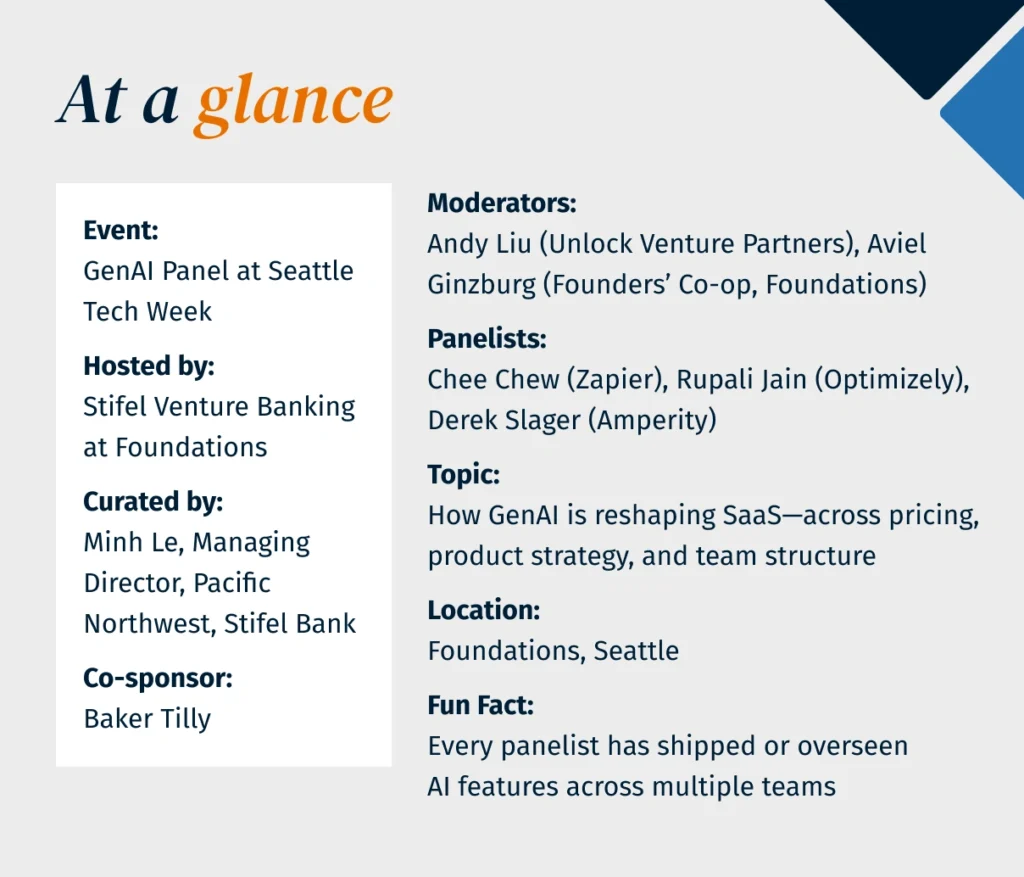The GenAI Era Has Arrived – Are You Ready?
Venture Banking

Minh Le (Managing Director, Stifel Venture Banking, Pacific Northwest & Western Canada) has spent years advising SaaS founders navigating shifting market dynamics. At Seattle Tech Week, he hosted a candid conversation with leaders from Zapier, Optimizely, and Amperity on how GenAI is reshaping SaaS — and what it will take for companies to adapt and thrive
Seattle Tech Week brought incredible energy to the city’s startup ecosystem. Among the many events I joined, one conversation stood out for its candor and urgency: a panel on how generative AI is redefining SaaS.
At Foundations, a collaborative community and workspace for Seattle founders, I curated a panel moderated by Andy Liu (Partner at Unlock Venture Partners) and Aviel Ginzburg (Partner at Founders’ Co-op and Co-founder at Foundations). Together, we brought three senior product and technology leaders from some of SaaS’s most recognizable names:
- Derek Slager, CTO, Amperity
- Rupali Jain, Chief Product Officer, Optimizely
- Chee Chew, Chief Product & Technology Officer, Zapier
This wasn’t a hype-driven conversation. It was an honest, forward-looking discussion about the pressures SaaS companies face and how they can adapt and thrive in the GenAI era.

SaaS Economics Are Facing a Reckoning
As Liu noted in his opening remarks, SaaS valuations have compressed significantly, trading today at 5–6x revenue compared to a five-year average closer to 11x. Meanwhile, Big Tech and AI-native startups are soaring. The SaaS model isn’t dead, but it’s under pressure to evolve—and fast.
Slager put it bluntly: “SaaS got fat.” Customers now expect more value from fewer vendors. Consolidation is coming, and companies that respond early will be the ones that endure.
Chew, meanwhile, offered a counterpoint from Zapier’s perspective: “AI is creating far more value for our customers while pricing hasn’t changed. The question is: how do we capture that value?”
And Jain noted that willingness to pay for AI is higher than many expect: “We monetized earlier than we thought we were ready, and customers leaned in. That’s pushed us to rethink our entire business model.”
The consensus was clear: SaaS economics are shifting fast, and agility in pricing will matter as much as agility in product.
Balancing Vision with Customer Caution
Enterprises know AI is the future, but many are still cautious. Slager described the tension well: “Everything’s changed and nothing’s changed. Customers don’t want to make a buying decision that looks foolish in twelve months. We have to take them into the future while meeting them where they are today.”
Chew compared it to the early days of the cloud, when companies insisted they’d never put data off-premises – until they did. The challenge, he said, is knowing which bets to place now and which to time with the market.
For Jain, meeting customers where they are means helping them stay competitive as the marketing landscape shifts. By reimagining how AI orchestrates campaigns, Optimizely is helping marketers optimize outcomes across the entire journey instead of just individual experiments.
Culture and Fluency Matter as Much as Product
If GenAI is reshaping products, it’s reshaping companies even more. To accelerate learning and force momentum, Jain set an ambitious mandate at Optimizely: every team had to ship an AI feature monthly. “It wasn’t smooth, but it shocked the system and forced velocity. We’re now delivering features in weeks that used to take years.”
Chew approached change through empowerment. Zapier launched a company-wide initiative, which included budget and broad empowerment to explore new tools and optimize their job with AI.“It created excitement instead of fear,” he said.
Meanwhile, Slager focused on leading with proof. “Once people saw the utility, skeptics converted themselves. Our engineers are tinkerers. They’ll figure it out.”
Across all three companies, one truth emerged: AI fluency is becoming a baseline expectation across the org chart. As Chew put it, “We all recognize that AI advancement is not stopping. All jobs in the industry will require AI fluency whether at Zapier or afterwards. We partner with our employees for them to be well-positioned for that future.”
Rethinking Product Development
Traditional roadmaps and PRDs (product requirement documents) are giving way to prototype-first approaches.
Jain explained: “Product requirements used to be about mapping steps. Now it’s about defining the outcome and proving why AI can’t get you there. Start from the result, then cut every unnecessary step.”
Chew was even more direct: “We don’t do PRDs anymore. Just build the V0 prototype and go from there.”
This shift isn’t just about speed. Rather, it’s about learning faster than competitors.
Building Moats in an Open-Model World
With foundation models widely available, what makes SaaS defensible?
- Data. Slager stressed that structured, proprietary data is Amperity’s edge. “Models aren’t the differentiator. Data is.”
- Connectivity. Chew pointed to Zapier’s workflow data across thousands of integrations, giving unique insight into user behavior.
- Speed. Jain added that in today’s market, velocity itself is a moat. “The ability to learn fast, ship fast, and iterate often can be the difference between surviving and getting left behind.”
Key Takeaways for Founders
Reflecting on this conversation, three lessons stand out for me as SaaS founders navigate the GenAI era:
- Leverage your depth: Proprietary data, customer relationships, and domain expertise are enduring advantages.
- Chase applications, not models: As Slager reminded us, GenAI itself isn’t the product. Differentiation comes from solving specific problems others can’t.
- Move fast: As Chew emphasized, speed of learning matters more than getting it perfect the first time.
The GenAI shift is a reckoning for SaaS, but it’s also an opportunity. Companies willing to rethink their products, culture, and business models won’t just survive the shift. They’ll define the next era.
Written by
Related Insights
Other articles designed to help you along your financial journey.




